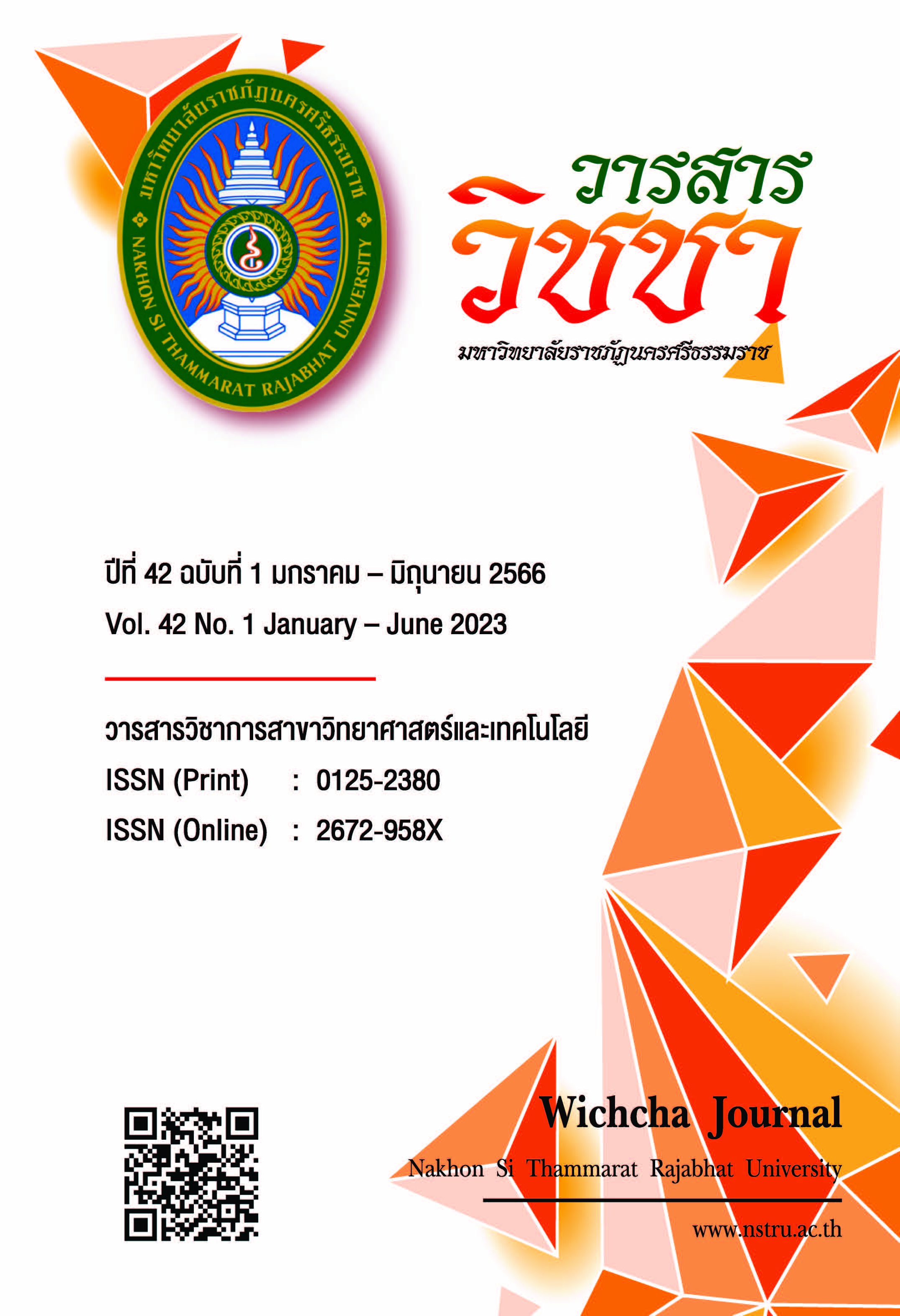Effect of Using Learning System on Cloud Integrated with Flipped Classroom on Atom and Atomic Structure for Developing Learning Achievement of Matthayom Suksa 5 Students
Main Article Content
Abstract
From the COVID-19 situation, its effect on human life to use science and technology in response to their needs, especially education that relates to students. The Development of Learning System on Cloud Integrated with Flipping Classroom on Atom and Atomic Structure will be developing learning achievement and reducing educational inequalities for students. The research tools consisted of a lesson plan, the learning achievement test, and the satisfaction questionnaire. The purposes of this study were 1) to compare the learning achievement of students before and after implementations of the cloud computing combined with flipped classes approach, 2) to compare the learning achievement of the experimental group after using the cloud computing combined with flipped classes approach, and the control group who used the traditional lecture approach, and 3) to investigate the satisfaction of students after implementations of the cloud computing combined with flipped classes approach. The samples were Matthayom suksa 5/7 students (n = 30). The samples were selected by purposive sampling. The results of this research showed that 1) the mean scores of posttest were significantly higher than pretest after implementations of the cloud computing combined with flipped classes approach (p < 0.05). 2) The mean scores of students’ posttest after implementations of the cloud computing combined with flipped classes approach were significantly higher than the control group who used the traditional lecture approach (p < 0.05). 3) It was found that the students’ satisfaction on learning by the cloud computing combined with flipped classroom approach was at highest level (Mean = 4.67, SD = 0.59).
Article Details

This work is licensed under a Creative Commons Attribution-NonCommercial-NoDerivatives 4.0 International License.
เนื้อหาและข้อมูลในบทความที่ลงตีพิมพ์ในวารสารวิชชา มหาวิทยาลัยราชภัฏนครศรีธรรมราช ถือเป็นข้อคิดเห็นและความรับผิดชอบของผู้เขียนบทความโดยตรง ซึ่งกองบรรณาธิการวารสารไม่จำเป็นต้องเห็นด้วยหรือร่วมรับผิดชอบใด ๆ
บทความ ข้อมูล เนื้อหา รูปภาพ ฯลฯ ที่ได้รับการตีพิมพ์ในวารสารวิชชา มหาวิทยาลัยราชภัฏนครศรีธรรมราช ถือเป็นลิขสิทธ์ของวารสารวิชชา มหาวิทยาลัยราชภัฏนครศรีธรรมราช หากบุคคลหรือหน่วยงานใดต้องการนำข้อมูลทั้งหมดหรือส่วนหนึ่งส่วนใดไปเผยแพร่ต่อหรือเพื่อการกระทำการใด ๆ จะต้องได้รับอนุญาตเป็นลายลักษณ์อักษรจากวารสารวิชชา มหาวิทยาลัยราชภัฏนครศรีธรรมราชก่อนเท่านั้น
The content and information in the article published in Wichcha journal Nakhon Si Thammarat Rajabhat University, It is the opinion and responsibility of the author of the article. The editorial journals do not need to agree. Or share any responsibility.
References
กิ่งกมล ศิริประเสริฐ และกอบสุข คงมนัส. (2564). ผลการจัดการเรียนรู้โดยใช้ห้องเรียนกลับด้านร่วมกับเกม Kahoot วิชาภาษาอังกฤษ ที่มีต่อผลสัมฤทธิ์ทางการเรียนและการกำกับตนเองของนักเรียนชั้นมัธยมศึกษาปีที่ 2. วารสารวิจัยและนวัตกรรม สถาบันการอาชีวศึกษากรุงเทพมหานคร, 4(2), 157-180.
เกรียงไกร พละสนธิ พัลลภ พิริยะสุรวงศ์ และพินันทา ฉัตรวัฒนา. (2559). รูปแบบคลาวด์เลิร์นนิงแบบสะตีมด้วยเทคโนโลยีความเป็นจริงเสริมเพื่อพัฒนาทักษะการสร้างสรรค์และนวัตกรรม สำหรับนักศึกษาระดับปริญญาตรี. วารสารวิชาการครุศาสตร์อุตสาหกรรม พระจอมเกล้าพระนครเหนือ, 10(2), 256-264.
เฉลิมพร เตชะพะโลกุล สกลธ์ชัย ชะนูนันท์ และจินตนา กล่ำทศ. (2562). การศึกษาการประยุกต์ห้องเรียนกลับด้านเพื่อพัฒนาสมรรถนะการแก้ปัญหาแบบร่วมมือของผู้เรียนในรายวิชาเคมี ระดับมัธยมศึกษาตอนปลาย เรื่อง ปริมาณสารสัมพันธ์. วารสารชุมชนวิจัย, 13(3), 173-187.
ชนสิทธิ์ สิทธิ์สูงเนิน. (2560). ห้องเรียนกลับด้าน: ทักษะการเรียนรู้ในศตวรรษที่ 21. วารสาร มจรสังคมศาสตร์ปริทรรศน์, 6(2 พิเศษ), 171-182.
ณัฎภัทรศญา เศรษฐโชติสมบัติ. (2562). ผลของการออกแบบแผนการสอนและการพัฒนาสื่อเทคโนโลยีสารสนเทศต่อผลลัพธ์การเรียนรู้. วารสารวิชชา มหาวิทยาลัยราชภัฏนครศรีธรรมราช, 38(2), 93-103.
เบญจพร สุคนธร และสมพงษ์ จิตระดับ. (2563). แนวทางการใช้ห้องเรียนกลับด้านในการเรียนการสอนวิชาเคมี สำหรับนักเรียนมัธยมศึกษาตอนปลายที่มีผลสัมฤทธิ์ทางการเรียนต่ำ. วารสารวิจัย มข. สาขามนุษย์ศาสตร์และสังคมศาสตร์ (ฉบับบัณฑิตศึกษา), 8(1), 13-24.
เบญจมาศ ฉิมมาลี และอนุชิต อนุพันธ์. (2562). การเรียนคณิตศาสตร์บนเทคโนโลยีการประมวลผลแบบคลาวด์สำหรับนักศึกษาปริญญาตรี. วารสารบริหารธุรกิจอุตสาหกรรม, 1(2), 5-15.
ศิริพล แสนบุญส่ง. (2560). การพัฒนารูปแบบการจัดการเรียนรู้ห้องเรียนกลับด้านโดยใช้เทคโนโลยีคลาวด์ ที่มีผลต่อผลสัมฤทธิ์ทางการเรียนรายวิชาคอมพิวเตอร์สำหรับครูของนักศึกษาปริญญาตรี. วารสารบัณฑิตศึกษา มหาวิทยาลัยราชภัฏวไลยอลงกรณ์ ในพระบรมราชูปถัมภ์, 11(พิเศษ), 133-146.
สำนักงานพัฒนาวิทยาศาสตร์และเทคโนโลยีแห่งชาติ. (2562). Cloud computing. สืบค้นเมื่อ 16 มกราคม 2562, จาก: https://www.nstda.or.th/th/nstda-knowledge/3071-cloud-computing.
Akçayır, G. and Akçayır, M. (2018). The flipped classroom: A review of its advantages and challenges. Computer & Education, 126, 334-345, doi: https://doi.org/10.1016/j.compedu.2018.07.021.
Anderson, L.W. and Krathwohl, D.R. (2001). A taxonomy for learning, teaching, and assessing: A revision of bloom’s taxonomy of educational objectives, pp. 64-66. New York: Addison Wesley Longman.
Arpaci, I. (2019). A hybrid modeling approach for predicting the educational use of mobile cloud computing services in higher education. Computers in Human Behavior, 90, 181-187, doi: https://doi.org/10.1016/j.chb.2018.09.005.
Bergmann, J. and Sams, A. (2012). Flip your classroom: Reach every student in every class every day. United States of America: ISTE and ASCD.
Bokosmaty, R., Bridgeman, A., and Muir, M. (2019). Using a partially flipped learning model to teach first year undergraduate chemistry. Journal of Chemical Education, 96(4), 629-639, doi: https://doi.org/10.1021/acs.jchemed.8b00414.
Hakak, S., Noor, N.F.M., Ayub, M.N., Affal, H., Hussin, N., Ahmed, E. and Imran, M. (2019). Cloud-assisted gamification for education and learning-recent advances and challenges. Computers and Electrical Engineering, 74, 22-34, doi: https://doi.org/10.1016/j.compeleceng.2019.01.002.
Hu, L. (2021). The construction of mobile education in cloud computing. Procedia Computer Science, 183, 14-17, doi: https://doi.org/10.1016/j.procs.2021.02.024.
Rau, M.A., Kennedy, K., Oxtoby, L., Bollom, M. and Moore, J.W. (2017). Unpacking active learning: A combination of flipped classroom and collaboration support is more effective but collaboration support alone is not. Journal of Chemical Education, 94(10), 1406-1414, doi: https://doi.org/10.1021/acs.jchemed.7b00240.


